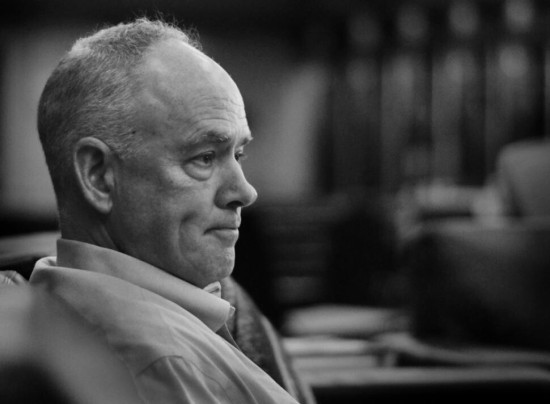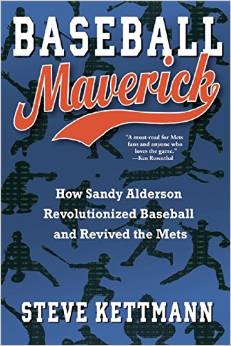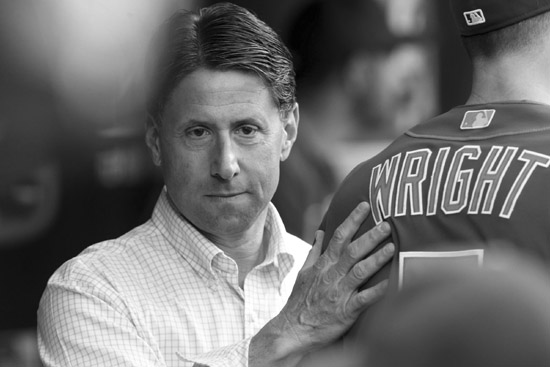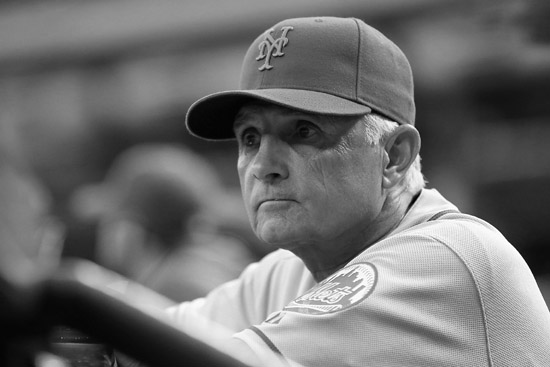
Here is an MMO exclusive interview with Steve Kettmann, author of the new Sandy Alderson bio, Baseball Maverick. We thank Steve for his graciousness and generosity in answering our questions. He is by all accounts a very busy man but still managed to make time for us. I tried to pick and choose questions on some of the more interesting aspects of the book without sacrificing Steve’s particular insight on a few issues that go beyond the book’s purview — particularly as he is a seasoned journalist and we don’t often have the ear of an industry insider. Hope you enjoy the interview.
 Matt Balasis (MMO): Steve, in Chapter 5 you talk about some of the antecedents of Sandy Alderson’s statistical approach. You mention Bill James and Eric Walker as influences, however you point out how Sandy drew on his own experiences as a fan, embracing Earl Weaver’s “get people on base and hit a three run homer” strategy. I find this interesting because we all have formative influences as fans and for many Mets fans Earl Weaver’s power approach clearly had its limitations. 1969 comes to mind. The Mets’ NL heritage is rooted more in Whitey Herzog’s small-ball approach and an overwhelming dose of pitching. In light of how ill-suited the Mets appeared in their own home confines in recent years, was there ever any discussion that you know of about how the Earl Weaver approach was maybe a poor fit? The Mets at times looked like a band-box team playing in a pitcher’s park.
Matt Balasis (MMO): Steve, in Chapter 5 you talk about some of the antecedents of Sandy Alderson’s statistical approach. You mention Bill James and Eric Walker as influences, however you point out how Sandy drew on his own experiences as a fan, embracing Earl Weaver’s “get people on base and hit a three run homer” strategy. I find this interesting because we all have formative influences as fans and for many Mets fans Earl Weaver’s power approach clearly had its limitations. 1969 comes to mind. The Mets’ NL heritage is rooted more in Whitey Herzog’s small-ball approach and an overwhelming dose of pitching. In light of how ill-suited the Mets appeared in their own home confines in recent years, was there ever any discussion that you know of about how the Earl Weaver approach was maybe a poor fit? The Mets at times looked like a band-box team playing in a pitcher’s park.
Steve Kettmann: Hence the choice to move in the fences at Citi Field not once but twice. Alderson has always emphasized pitching. You think of his A’s teams and what comes to mind? A loaded lineup, sure, but also Dave Stewart and Bob Welch and Dennis Eckersley. One of the things that came through in my research was the extent to which Alderson did not develop a new offensive philosophy as he delved deeper into statistical analysis, he merely found a vocabulary to articulate what he already believed. Eric Walker told me he didn’t think Alderson’s basic philosophy shifted much over the years at all. So Alderson, talking to me, compared the Weaver approach to the bunt-‘em-over small ball of Gene Mauch and then dismissed that as a viable option, saying, “Baloney! You get a couple guys on and hit a bomb. That’s how you win games.” That’s the Alderson view. No one who writes about baseball for a living is ever inclined to make too much of spring training – they’re just practice games – but compared to last year, it’s interesting to see that the Mets this spring have relied on the long ball to win. Going into Wednesday’s games, they were third in homers as a team with 38, behind only the Dodgers and Cubs, and at 18-11, first in the Grapefruit League.
Matt Balasis (MMO): On the subject of steroids and their effects, given this front office’s statistical predilections, have there been any efforts to your knowledge to establish post-steroid era norms?
Steve Kettmann: I’m not sure that we have entered a “post-steroid” era or that we ever will. The cheaters are smarter and more sophisticated now than they were, and juicing is less prevalent; we’d be naive to think it no longer occurs.
Matt Balasis (MMO): Any insight on how very little love appears to be lost between Alderson and Boras? Is it just a personality thing or is there more to it? On page 243, did Boras try to undermine Sandy Alderson by talking directly to Jeff Wilpon? Did Jeff Wilpon rebuff the breach in protocol? Anything else you can tell us here?
Steve Kettmann: If the word we’re using is “love,” you have to work pretty hard to find people in baseball – other than his clients – who “love” Boras or are “loved” by him. We’re talking about a man who has clearly internalized Machiavelli’s dictum that there is “greater security in being feared than in being loved.” I actually think he and Alderson have a good relationship; they are two strong figures who know just how much they are willing to take from someone else, and I think each enjoys watching the other operate.
Boras is well known for going around general managers and trying to deal with owners whenever possible. Why not? He’s the most powerful agent in the game, he might as well leverage that status when and if he can. His effort to go around Alderson and straight to ownership on Stephen Drew was not successful; I think that fact speaks to a strong working relationship between Alderson and the Wilpons. I’d also point out: Good move by the Mets not to sign Drew.
Matt Balasis (MMO): On page 135 you talk about Alderson creating a new culture and rebranding the Mets, was there ever any discussion about alienating a fan-base that already felt slighted over Citi Field’s Dodger-themed homage to Ebbets, and how for many fans there was already a Mets culture in place apparently unbeknownst to ownership?
 Steve Kettmann: I think it was important Fred Wilpon admitted that mistakes were made when it came to designing Citi Field. “All the Dodger stuff – that was an error of judgment on my part,” he told The New Yorker in May 2011. Those choices predated Alderson joining the Mets in late 2010. Safe to say, though, that there are unending discussions in the Mets front office about how to engage the Mets’ fan base and have those people feeling excited about the team – and connected with Mets history. Going into the 2015 season, there are indications on numerous fronts that they’re on their way to doing that, but we all know it comes down to wins and losses in the regular season – and to appearances in the playoffs. When Alderson flew down to Virginia in late 2012 to play golf with David Wright and discuss the future of the team, it was in a sense as if Wright was serving as a spokesman for the fans: He wanted to know that the team had a plan to become a force again, not just to make a dip into the playoffs every few years, but to become a fixture there. That is the goal toward which Alderson and his assistants have been working and even doubters are starting to think they’re now on track. I’ve taken some flak for the second verb in the subtitle of my book, “How Sandy Alderson Revolutionized Baseball and Revived the Mets,” but I stand by it 100 percent, as I explained in a recent New York Daily News article. – I do think the Mets are revived.
Steve Kettmann: I think it was important Fred Wilpon admitted that mistakes were made when it came to designing Citi Field. “All the Dodger stuff – that was an error of judgment on my part,” he told The New Yorker in May 2011. Those choices predated Alderson joining the Mets in late 2010. Safe to say, though, that there are unending discussions in the Mets front office about how to engage the Mets’ fan base and have those people feeling excited about the team – and connected with Mets history. Going into the 2015 season, there are indications on numerous fronts that they’re on their way to doing that, but we all know it comes down to wins and losses in the regular season – and to appearances in the playoffs. When Alderson flew down to Virginia in late 2012 to play golf with David Wright and discuss the future of the team, it was in a sense as if Wright was serving as a spokesman for the fans: He wanted to know that the team had a plan to become a force again, not just to make a dip into the playoffs every few years, but to become a fixture there. That is the goal toward which Alderson and his assistants have been working and even doubters are starting to think they’re now on track. I’ve taken some flak for the second verb in the subtitle of my book, “How Sandy Alderson Revolutionized Baseball and Revived the Mets,” but I stand by it 100 percent, as I explained in a recent New York Daily News article. – I do think the Mets are revived.
Matt Balasis (MMO): In chapter 10 you talk about Selig’s nod to Alderson as Mets GM … I don’t want to read into this too much, but between the MLB loan extended to the Wilpons, the Madoff mess, and Ownership’s debt burden, was Selig’s “approval” of Alderson more of an offer the Wilpons couldn’t refuse? If I’m the Wilpons at this juncture I wouldn’t want to do anything to get on Selig’s bad side.
Steve Kettmann: Fred Wilpon and Bud Selig go way, way back, as Selig reminded me when I interviewed him for the book. They are not just work friends, but personal friends, and their families are close as well. Fred Wilpon could not get on Selig’s bad side at this point even if he tried. Also, Fred Wilpon is not a man who does things because someone else demands that he do so. Selig took an interest because the franchise was in trouble. It needed help. Alderson was a good fit. As John Ricco, the Mets GM at the time, told me for the book, it was widely assumed that the job was Alderson’s if he wanted it, his qualifications were that strong.
Matt Balasis (MMO): The beginning of Chapter 11 is one of my favorite parts of the book. It gives the reader a brief but lucid insight into a media landscape rarely seen … your language takes on a passionate and forceful elocution in discussing how the industry has in a sense degenerated into a banal and obtuse transfer medium for wholesale sports information. Peddling quotes, statistics, salary figures, and rankings, appears to take up the bulk of exchanges in most press-boxes that I’ve been privy to, with only an occasional substantive exchange – almost always involving an older established journalist, someone like Patrick Reusse. It’s as if any thought provoking feature would be too long on the attention span to survive the cut in this age of instantaneous information. Where do you see the industry going in the next 10, 15, 20 years?
Steve Kettmann: A funny thing about that passage: I wrote it on my laptop sitting in a bar at the Gaylord Opryland Hotel in Nashville, right in the middle of that crazy, garish scene I describe, so it captured my perspective at the time. I was a little surprised when I showed up in San Diego this past December for the most recent version of the winter meetings, and found a much different sort of dynamic. Partly that was just that Mets people were all in a great mood, feeling like the team was in the best shape it had been in for years. But everywhere I went, there was a lot of energy and excitement, a great vibe. That had to do with the spectacular setting near the beach in Southern California, but also, I think, reflected more comfort with the new realities. Social media is here to stay. Twitter matters. I myself had avoided Twitter, but that visit to San Diego shifted my thinking: if you wanted to know what was going on, you followed the Twitter feeds of people like Ken Rosenthal, Jon Heyman and Buster Olney. Now, I don’t love everything about Twitter. It still cracks me up when someone tweets to me – at @stevekettmann – “If you can’t explain your book in one tweet, I won’t buy it” or some such: Books take time, time to open up actual insight. So to get back to your question, it’s my view that books will play an ever more important role in the discussion on sports. Twitter is pushing all media toward quicker attention spans; books hold down the other end, offering more story-telling, more insight into the people who make sports happen, and simply a more considered view. I think books – and ventures like Derek Jeter’s publishing enterprise – will matter more and more.
Matt Balasis (MMO): In the chapter “Come On, Blue!” you talk about the depth and quality of Mets pitching. In light of the organization’s vested interest in protecting their pitching assets, have there been any discussions to your knowledge on incidence and prevention of UCL injuries? Surely it must occur to this front office that an effective protocol which could mitigate risk factors and head off injury would give the originating team a colossal advantage.
Steve Kettmann: I wrote a piece for Wired back in 2002 on “The Science of Pitching, Redux” – looking at the Oakland A’s attempts to be smart in preventing injuries to pitchers. But you know what? A’s pitchers still got hurt. The Mets organization certainly has pondered this question at length, and I believe we will see more innovations relating to individualized regimens for every player in the organization, focusing on diet and nutrition, stretching, weight lifting and mental health and mental-strength conditioning. Too often in old-school baseball the notion was that everyone did the same drills, the same stretching, the same weight work – and if it was hard for some of them, well they ought to toughen up. I expect the Mets to move in this direction in a big way.
Matt Balasis (MMO): There’s been a lot of speculation about why so little attention was focused on the Wilpons. Yes the book is about Sandy Alderson, but one question that many Mets fans have is whether a lot of the stories that have been floated over the years about the Wilpons are true. In particular Jeff Wilpon has often been painted as difficult and meddlesome. Was this ever an issue for Sandy? Many have openly speculated that one of the reasons Alderson was recommended for the position by the Commissioner was precisely because he had the clout and bearing to resist tampering from sources outside of his baseball operations department … would you concur?

Steve Kettmann: Is Jeff Wilpon sometimes difficult? Of course he is. Is Sandy Alderson sometimes difficult? Of course he is. Is Fred Wilpon sometimes difficult? Of course he is. One thing we all know – fans, media, book authors – about each of these three individuals is that they all badly want to win and hate losing. They might not show that with Steinbrenner-style tantrums, but not everyone craves drama the way he did. Alderson told me that far and away the toughest part of the job of GM is having to deal with the sting that each loss brings. The view from the outside may cast each of these three at times as aloof and above it all, but when it comes to being frustrated over a loss, or a losing season, most fans would be amazed to know how similar the reactions of the Wilpons and Alderson are to their own. That’s my honest take on it. The Wilpons hired Alderson because it made sense, and they’ve given him the time to change the culture of the organization and instill a new attitude. To do that, he needed the standing of having been in the game for years. Alderson has built up a lot of respect. There’s a reason why he heads baseball’s rules committee. I laugh when people – perhaps just reading the title – take shots at the book for trying to build Alderson up as a genius. Alderson is no genius. He’s a smart guy and a good leader who has been shaped by a fascinating and diverse series of life experiences, from working for the CIA briefly when he was young to having a press pass as a credentialed war correspondent during the Vietnam War to showing up in the Oakland A’s front office just in time to witness the genius of Billy Martin. My focus in the book is on a biographical study of a figure I see as being interesting partly because he’s unique, and partly because he strikes me as a kind of everyman, someone who could easily have wound up in any number of other careers. It just so happens that through his own experiences in the game, from the 1980s to now, Alderson’s life provides a window into the evolution of baseball. That’s my larger subject in the book, and I hope readers who take the time to give the book a careful reading will, by the time they’ve come to the last page, enjoy that panoramic aspect of the book.
Matt Balasis (MMO): You mention the peanut gallery in chapter 18. There seems to be a lot of discontent in comment boards across the Mets blogosphere, much of it divided into two camps, the anti-Alderson contingent and the Alderson apologists, I’m not sure I can remember a time when Mets fans were more divided on a GM. Why do you think this particular GM has been so polarizing?
Steve Kettmann: I defer to your greater sense of the Mets fan base, but from where I sit, it was amazing that Alderson’s insistence on a patient approach to rebuilding has been accepted and supported by as many fans as it has. No fan wants to defer until tomorrow the pleasures of rooting for their team with the hope of winning the World Series. They want immediate results. Instead they’ve had to be patient – especially when Matt Harvey’s injury pushed everything back a year. They’ve had to deal with a “Groundhog Day” sense that this rebuilding effort was taking forever. Of course some frustration with Alderson has come through. That’s what happens when the team does not win. Did Steve Phillips have both his advocates and detractors among fans? He sure did. Did Omar Minaya? He sure did. What’s polarizing is losing. Fans seem excited by the potential of this year’s Mets and buoyed by the team’s performance this spring – and maybe you’d disagree, but what I’m seeing from sportswriters is a sense that this team has a good shot at being ready to compete from Opening Day. Keep in mind that the last two seasons, the Mets did well late in the season; it was their early-season doldrums that sunk them and in particular a porous bullpen, which has now been upgraded significantly. So if they can improve noticeably in April, there’s reason to think that could bode well for the rest of the season.
Matt Balasis (MMO): What inspired you to write this book?
Steve Kettmann: I loved the challenge of trying to capture a complex figure and show rather than tell readers some of the chapters of his life, which offer a unique and illuminating perspective on baseball in recent decades, and having covered Alderson and Billy Beane back in the 1990s, years of observation gave me insight – and contacts – that I knew made me well equipped to tell this story. To me Sandy Alderson is an inspiring figure on several levels; this is not the sort of book clogged up with a lot of pro forma space-filler quotes, just to show one made a call and did some typing, quoting people sounding off on this or that “on the other hand” aspect of Alderson’s life in baseball. What interests me about the story is looking at the way that one experience in Alderson’s life led to another, and had an impact. He had an amazing mentor in his Oakland years in A’s president Roy Eisenhardt, a law professor, a Renaissance Man in the truest sense, and he came into baseball under the leadership of the Haas family, who got into baseball for the simple reason (slip your cynicism off at the door, please: facts are facts) that they wanted to help the community of Oakland, and that’s what they did, too, re-imagining along the way what a baseball team could be. That was an era of dynamism that I try to capture in my book, and I think anyone who reads it can’t help but get caught up in some of the excitement, the same sort of excitement that one feels nowadays visiting Google. (That’s no metaphor – Google is an hour from my front door and I am always amazed at the energy of the place when I visit.) Alderson has always been about working with others and trying to get the best out of them; in Oakland, he was lucky to have some great people around and that made him better at what he did. Later, he passed that on to Billy Beane and others. It’s my belief, and that of many, that in this passing on to others, a revolution in baseball was set in motion. That to me is a lively story line for the reader to follow. I hope I’ve done some justice to it here.

Matt Balasis (MMO): The 2014 Mets seemed to follow a pattern of blowing an opponent out then losing a bunch of close ones. There was this perception that they should have been better than their record. On page 285 you discuss Pythagorean win theorem and run differential and in Hanging by a Thread you reveal that Alderson was at one point considering cutting Collins loose. Given the fact that 2015 is shaping up to be a make or break year for the organization, why do you think he decided to stick with Collins?
Steve Kettmann: Terry Collins has learned from his mistakes to become a manager who is very good at staying connected to his players. He’s done good work in leading the team forward and earned the right to get a shot at winning this season. That’s Alderson’s view, and it’s one that many others, myself included, share. Yes, there were frustrations last year and I think anyone who reads that chapter will get a good look at some of the things that happen behind the scenes that fans do not hear about. But its importance also shouldn’t be overstated. That was one flare-up in tension over a long season, and in general Alderson and Collins clearly have a good rapport. They both know that if the team struggles in 2015, it’s on them – and there will be consequences.
Matt Balasis (MMO): To this day, Alderson’s greatest claim to fame is his transformative approach to market inefficiencies in Oakland which enabled him to construct competitive teams on some very limited payrolls. Establishing a successful franchise in baseball’s largest market on a proverbial dime would open a lot of eyes given the staggering profit margin at stake in NY. Do you believe there may be an opportunistic “small-marketization” experiment being conducted in our midst largely orchestrated by forces in MLB ownership who would trumpet a paradigm of big market contention achieved on a limited budget? It’s no secret that Selig bemoaned big market spending trends … with Sandy Alderson (knowingly or not) spearheading the effort, a low budget contender in a big market could set quite a precedent. Do you think there may be any substance to this?
Steve Kettmann: Actually, the Oakland A’s teams under Alderson in the 1980s and into the early 1990s were high payroll teams. They won the World Series in 1989 with a payroll of $17.5 million, which was fifth in baseball that year, behind only the Mets ($21.2 million), Dodgers ($21.1 million), Red Sox ($19 million) and Yankees ($18.4 million). Alderson’s greatest claim to fame in those years was probably not even winning the World Series, but pulling off the feat of having three straight Rookies of the Year in Jose Canseco, Mark McGwire and Walter Weiss. Alderson would love to repeat that run in New York, starting with 2014 Rookie of the Year Jacob deGrom. In other words, for all the justifiable attention paid to Alderson’s belief in advanced statistical analysis, he looks to scouting and player development as a crucial part of the project of turning the Mets back into consistent winners. Major League Baseball needs to have at least one exciting, strong team in New York and the Yankees have had a nice run, but look to be in for a time of transition. Baseball needs the Mets to make some playoff runs and help boost October ratings, which have been sagging. I think that concern trumps any desire to slow down runaway spending – and I myself would love to see the Mets in the playoffs, Matt Harvey starting Game 1, Juan Lagares making a flying catch in the gap to rob a hitter, the imagination just keeps spinning. Any sportswriter who is honest will admit that yes, we in the press box do root – we root for story lines. A Mets’ return to postseason baseball would be a great story line.
A few brief reflections:
I have to say, I was a little floored by Steve’s thoughtful and comprehensive attention to my questions. He’s confirmed some of our suspicions about Scott Boras, and his answer to the steroid question was almost ominous. I found his response to question 6 on the direction of the industry enlightening — I agree that there is a polarization of sorts in the media with the instantaneous and the comprehensive drawing a higher share of focus at the extremes. Hopefully books like Kettmann’s will continue to offer the breadth and depth that more complex topics demand.
I wanted to mention also that Alderson as a kind of everyman is a perception I share … Sandy granted me an interview a couple of years back in the midst of a blizzard in Minnesota without questioning my credentials or affiliation which was a surprise to say the least, but his passion for the team was palpable. I think a lot of fans focus on “results” and fail to appreciate how difficult changing an organization’s culture is — the book really brings this out. It’s not just about Alderson the man but his influence on those around him. As a former Marine myself I admit there may be some bias here but I’ll take it if it engenders some insight on my part, which I think it does … Alderson’s bearing, confidence, intellect, and passion embody many of the traits that make Marines, Marines … So yes, I admit, I’ve been rooting for the guy because I know how transformative good leadership can be, and because I want sustained Met success, not a flash-in-the-pan one year thrill ride.
As far as the raised eyebrows over the “revived” language on the book’s cover … I’ve come to see Steve’s point. The Mets are revived in a very important sense, namely the groundwork for sustained success is there. I agree with Verducci and Kettmann and others that this team should be competitive. I’ve said it before — they almost have to be successful at some point given the talent build-up in the minors — Baseball is still a young man’s game and pitching wins championships … the Mets are well positioned in both respects.














